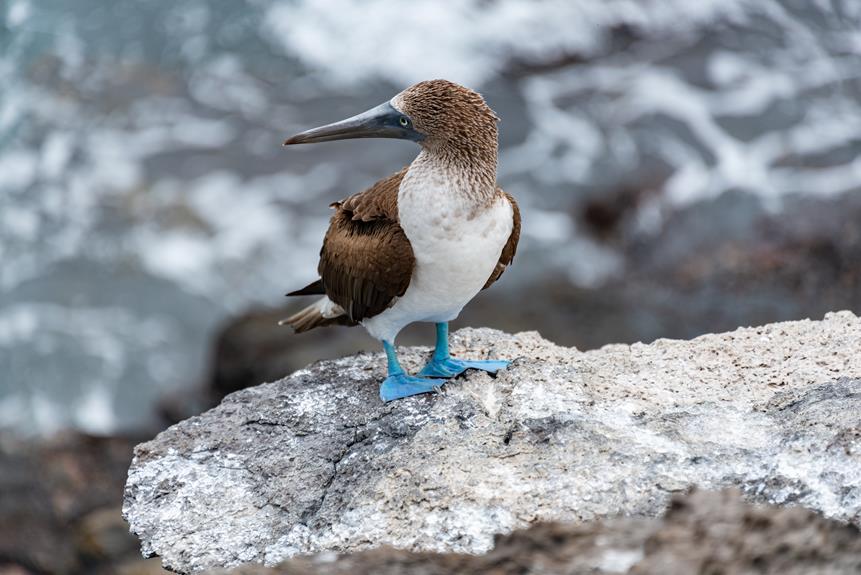
As I stroll along the sandy shores of Spain, I am captivated by the remarkable abundance of wildlife that thrives in this coastal paradise. Spain's beaches are not just a retreat for sun-seeking tourists, but a haven for a diverse array of creatures. From the graceful dolphins frolicking in the azure waters to the elegant flamingos wading in the marshes, this coastal ecosystem is teeming with life. Join me as we delve into the wonders of Spain's beaches and uncover the secrets of its thriving wildlife.
Key Takeaways
Table of Contents
- Marine conservation efforts in Spain have resulted in the establishment of marine protected areas and strict regulations to maintain the health and diversity of marine species.
- Tourism has both positive and negative impacts on marine life, and initiatives are being implemented to protect fragile ecosystems through the promotion of responsible tourism practices.
- Spain's shores offer excellent birdwatching opportunities, with a wide array of avian species, and conservation efforts are focused on protecting breeding grounds and preserving avian habitats.
- The Spanish coastline is a biodiversity hotspot for reptiles and amphibians, but uncontrolled tourism and urban development pose threats to their habitats. Conservation initiatives, including protected areas and responsible tourism, aim to protect and raise awareness about these species.
Rich Biodiversity at Spanish Beaches
I have observed a remarkable abundance of marine life thriving at Spain's beaches. One of the reasons for this rich biodiversity is the presence of marine protected areas along the coast. These areas have been established to conserve and protect the delicate ecosystems found in the region. Through strict regulations and conservation efforts, these marine protected areas have helped to maintain the health and diversity of marine species. The protection of these areas has also allowed for the recovery of threatened species and the preservation of important habitats. It is truly impressive to witness the positive impact that these conservation efforts have had on the marine life along Spain's beaches. The presence of marine protected areas serves as a testament to the commitment of Spain towards the preservation of its natural heritage.
Marine Life Encounters on Spain's Shores
A variety of fascinating marine creatures can be encountered along the shores of Spain. From the playful dolphins swimming in the Mediterranean Sea to the majestic sea turtles that call the Atlantic coast their home, Spain's marine life is truly diverse and captivating. However, the impact of tourism on these fragile ecosystems cannot be ignored. Efforts are being made to protect and conserve marine life in Spain through various conservation projects and initiatives. These include the establishment of marine protected areas, the promotion of responsible tourism practices, and the education of locals and tourists on the importance of preserving these precious habitats. By prioritizing marine life conservation efforts, Spain is working towards ensuring the long-term survival of its remarkable marine species.
Avian Paradise: Birds of Spain's Beaches
The diversity of marine life along Spain's shores extends beyond the water, with a wide array of avian species making the beaches their home. Spain's beaches provide excellent birdwatching opportunities, attracting bird enthusiasts from around the world. From the majestic flamingos in the wetlands of Doñana National Park to the graceful seagulls soaring along the coast, there is no shortage of avian wonders to behold. These beaches also serve as important breeding grounds for many species, sparking conservation efforts to protect their habitats. Conservation organizations work tirelessly to preserve these areas, ensuring that future generations can continue to enjoy the beauty of Spain's avian paradise. By supporting these conservation efforts, we can help maintain the delicate balance between humans and wildlife, ensuring that Spain's beaches remain a haven for both.
Reptiles and Amphibians Along the Spanish Coastline
Spotting reptiles and amphibians along Spain's coastline is a thrilling experience that never fails to fascinate me. The diverse range of species found in this region is a testament to the country's commitment to marine conservation efforts. However, the impact of tourism on these delicate ecosystems cannot be ignored. Here are some key points to consider:
- Biodiversity hotspots: The Spanish coastline is home to a wide variety of reptiles and amphibians, including the Iberian ribbed newt and the Spanish terrapin.
- Habitat destruction: Uncontrolled tourism and urban development pose a significant threat to the habitats of these species, leading to loss of biodiversity.
- Conservation initiatives: Spain has implemented various measures to protect these creatures, such as creating protected areas and promoting responsible tourism practices.
- Educational programs: Raising awareness among locals and tourists about the importance of conserving reptiles and amphibians is crucial for their long-term survival.
Mammals Thriving in Spain's Coastal Ecosystems
I have been amazed by the abundance of mammals thriving in Spain's coastal ecosystems. The country's commitment to mammal conservation efforts has played a crucial role in protecting and preserving these species. The diverse range of mammals found along the Spanish coastline is a testament to the success of these conservation initiatives. However, the impact of tourism on mammal populations cannot be ignored. With Spain being a popular tourist destination, it is important to strike a balance between promoting tourism and ensuring the well-being of these mammals. Strict regulations and guidelines have been put in place to minimize the disturbance caused by tourists and to protect the natural habitats of these animals. Ongoing research and monitoring are essential to assess the long-term impact of tourism and to implement effective measures for the sustainability of mammal populations in Spain's coastal ecosystems.
Frequently Asked Questions
What Is the Average Temperature of Spain's Beaches?
The average temperature of Spain's beaches is ideal for marine life exploration. It provides a comfortable environment for various species to thrive, contributing to why these beaches are a haven for wildlife.
Are There Any Endangered Species That Can Be Found Along the Spanish Coastline?
Yes, there are endangered species along the Spanish coastline. Threats to wildlife in Spain's coastal ecosystems include pollution, habitat destruction, and climate change. Protecting these species is crucial for their survival and the health of our environment.
What Measures Are Being Taken to Protect the Wildlife and Their Habitats in Spain's Coastal Ecosystems?
I'm taking measures to protect wildlife habitats along Spain's coast. Conservation regulations are being implemented to preserve the diverse ecosystems and ensure the well-being of the wildlife that inhabit these areas.
Can Visitors Go Snorkeling or Scuba Diving to Explore the Marine Life in Spain's Beaches?
Yes, visitors can go snorkeling or scuba diving to explore the marine life in Spain's beaches. There are plenty of snorkeling opportunities and scuba diving experiences available for those who are interested in underwater exploration.
Are There Any Specific Regulations or Restrictions in Place to Ensure the Conservation of Spain's Beach Wildlife?
Are there regulations or restrictions in place to ensure the conservation of Spain's beach wildlife? Absolutely! Conservation measures such as protected areas, nesting zones, and restrictions on human activities are enforced to safeguard the wildlife and their habitats.




Leave a Reply
You must be logged in to post a comment.